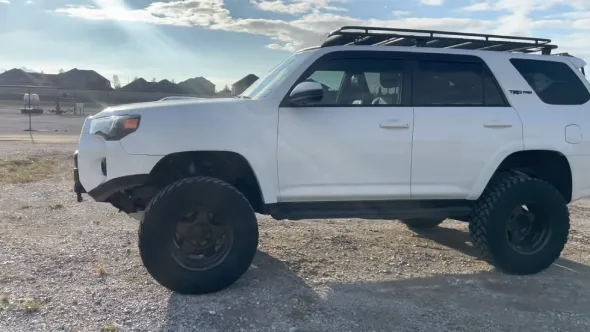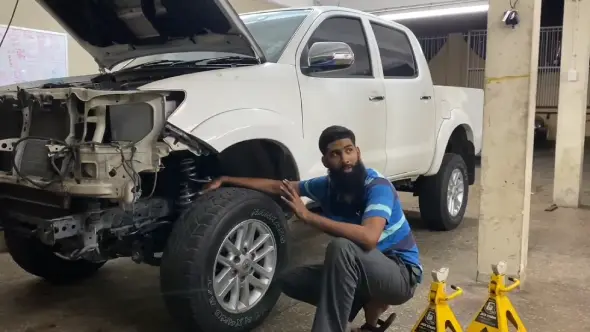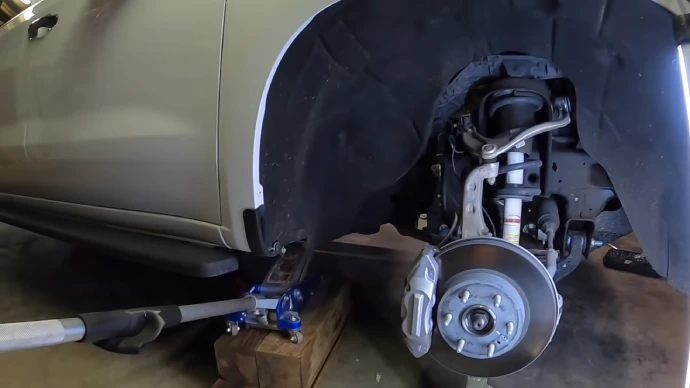Last Updated on May 7, 2023
Body and suspension lifts are popular modifications for off-road vehicles, but can you put a body lift on top of a suspension lift?
Combining a body lift with a suspension lift can dramatically increase your truck. Still, it’s important to consider the details before taking on this task. You’ll need to ensure the compatibility of components, assess any legal restrictions, and account for the height and size of the lifts.
As you evaluate potential solutions to improve your vehicle, consider their drawbacks. Becoming top-heavy or experiencing component damage due to uneven tire wear caused by poor alignment are risks that should not be overlooked. Here we’ll explore what you should know before embarking on such an upgrade.
Can You Put a Body Lift on a Suspension Lift: Factors to Consider

Vehicle owners may consider adding body lift kits on top of suspension lift kits to gain additional clearance and achieve a more off-road-ready appearance. While such modifications can be beneficial, consider several factors before deciding what type of lift is the best for you and your vehicle.
1. Height of Lift and Size of Body Lift:
When contemplating a body lift, one must consider the size and height best suit their vehicle’s needs. Body lifts range from 1 inch up to 4 inches, with the majority being between 1-2 inches.
It is important to choose the right size for the desired clearance. Too much space can create an unsightly look, while too little won’t provide sufficient space underneath the vehicle.
One should consider carefully how high they would like their lifted body to sit above their wheels. This could affect your vehicle’s performance off-road or its aerodynamic properties while driving at higher speeds.
2. Compatibility of Components:
Consumers should also ensure that all components that come into contact with the body lift are compatible before making any modifications.
Different types of components require different levels of support and torque for them to function correctly. Things such as brake lines, fuel tanks, and drive shafts could be affected by a lift if not properly accounted for.
It is also necessary to consider any aftermarket parts that one might be planning on installing when looking at compatibility with the body lift. Many aftermarket performance parts have specific requirements for clearance, which could be affected by an added body lift.
3. Legal Restrictions and Regulations:
In some areas, there may be legal restrictions in place prohibiting certain types or sizes of lifts from being installed on vehicles due to local laws or regulations. These restrictions should always be taken into account before beginning any modification process.
Many places have specific height requirements for vehicles traveling on highways or major roads. These requirements vary from state to state, but anything over 10 inches generally may be illegal, depending on where you live.
Advantages of Putting A Body Lift On A Suspension Lift

A body lift, when combined with a suspension lift, offers a variety of advantages to the vehicle. The combination of two lifts allows for improved off-roading performance, increased overall vehicle height, clearing for bigger tires, and the ability to customize your ride while saving you money.
1. Clearance for Bigger Tires:
Installing a body lift kit on a suspension lift allows larger and heavier tires to be added. A suspension lift can raise your vehicle’s profile and provide additional ground clearance.
Adding a body lift will enable you to fit even larger tires without cramping up space around the wheel wells or rubbing them against any part of the vehicle’s interior. This adds even more ground clearance and durability to your ride, allowing you to customize it with whatever type of tire meets your needs.
2. Increased Overall Vehicle Height:
Combining both lift leveling kits creates even more space between the frame and wheels. It ensures that all other components, such as fenders and bumpers, are kept at an appropriate distance from the road surface.
Not only does this make it easier to navigate obstacles off-road, but it also makes it easier for taller drivers or passengers to get in and out of the car more comfortably. This extra height gives you a better view of what lies ahead on difficult terrain.
3. Improved Off-Roading Performance:
Combining a body lift and suspension lift can offer improved off-roading performance due to its greater ground clearance and higher center of gravity. It provides better control over uneven terrain.
The larger tires can help grip obstacles like mud or sand without slipping back down slopes like smaller tires might do. Depending on conditions, you can gain extra traction if you choose aggressive tread patterns for those larger tires.
4. Ability To Customize Your Ride:
Adding both lifts together gives you much more freedom when customizing your ride’s look. Their combined size allows for longer shocks and wider rims that would otherwise be too large with just one type of lift alone.
Many shops offer great deals on packages that include both types of lifts where they install multiple parts together simultaneously. It helps save time and money in comparison with buying each piece separately.
Disadvantages of Staking a Body Lift on a Suspension Lift

Installing a body lift on a suspension lift can be a convenient way to increase the ground clearance of your vehicle, but it is important to understand its potential drawbacks.
1. Become the Top Heavy
Fitting a body lift on top of an existing suspension lift can make the vehicle top-heavy if too much weight has been added above your axles. When lifting either your suspension or a body lift, you are increasing your vehicle’s center of gravity (CG).
It leads to increased levels of instability when driving at higher speeds or in windy conditions. This could result in decreased control over the vehicle and an increased risk of accidents or rollovers. Because the center of gravity will be higher than normal, braking distances will also be longer due to reduced levels of traction.
2. Potential Damage to Vehicle Parts and Components
Additional stress can be placed on the frame and other vehicle parts due to fitting an extra layer onto an already lifted suspension. This could lead to vibration issues, premature wear and tear, and even deformations in certain parts, such as wheel arches or mudguards. It ultimately results in costly repairs if left unchecked.
3. Uneven Tire Wear
If not fitted correctly, any type of lift kit can cause problems with proper alignment, leading to uneven tire wear over time. This is especially likely if you opt for a larger body lift than is strictly necessary.
This could mean that there are alterations made to the steering angle geometry, which could cause tires to wear more quickly than normal.
4. Possible Warranty Restrictions from Manufacturer
Installing any kind of modification may void any warranty you have in place from your manufacturer or dealership. It is, therefore, important to check whether any modifications you make will affect your cover before proceeding. You may also find yourself out-of-pocket for all kinds of repair work later down the line.
What are the Differences Between the Suspension Lift & Body Lift for Chevy Tahoe?
Suspension lift kits raise both the frame and body simultaneously, while body lifts only raise the body from the frame, leaving it suspended in the air. Let’s compare and contrast these two types of lifts for Chevy Tahoe:
1. Installation Time
When installing a suspension lift on your beloved Chevy Tahoe, you should plan for 10 to 15 hours. The installation process includes raising the suspension with spacers or new components, adjusting steering and drivetrain angles, relocating shock absorbers, and more.
Conversely, installing a body lift on your Chevrolet Tahoe typically takes 2 to 7 hours. This involves mounting brackets onto existing holes in the frame and bolting them down around each side of the vehicle. In most cases, you do not need further modifications to install a body lift.
2. Ground Clearance
One key difference between body and suspension lifts is that when adding a body lift on the Chevy Tahoe, you will not change its ground clearance because it does not actually increase how far up off the ground the frame is lifted.
Meanwhile, suspension lift kits provide additional ground clearance by raising your vehicle’s frame and body simultaneously. It could add a couple of inches to your vehicle’s overall height and give you more space underneath for bigger tires or off-roading performance accessories like skid plates.
3. Center of Gravity
Suspension lift kits also provide an advantage over body lifts in terms of center of gravity. Installing a 3-inch suspension lift kit on your Chevy Tahoe will increase its center of gravity by about 3 inches.
In the meantime, installing a 3-inch body lift will only elevate the vehicle’s center of gravity by .60 inches or less. It keeps most parts higher than stock but does not raise them from their original position, like suspension kits.
Suppose you want maximum center of gravity adjustment for better on-road performance or improved off-roading capabilities. In that case, you should opt for a suspension kit rather than just going with a simple body lift setup.
4. Large Tire Fitments
When fitting large tires into place after lifting your truck with either method mentioned here, neither provides what many would call ‘amazing’ results. But they provide some benefits over stock tire fitment sizes without having done anything yet.
With just an ordinary 3-inch body lift installed onto your Chevy Tahoe independently from any other modifications, tire fitment sizes up to 33 inches are possible. Whereas with a full 3-inch suspension lift installed, tire fitment sizes are available up to 37 inches in diameter instead.
5. Lifting Height
Suspension lifts are popular for Chevy Tahoe, as they can raise the frame from 2–9 inches. These lifts also significantly increase wheel clearance, allowing owners to fit larger tires easily.
Body lifts add height to the vehicle but are generally more limited than suspension lifts, usually only raising the body 2–5 inches off the frame. This lift type provides less wheel clearance but allows owners to fit larger tires than stock.
6. Vehicle Handling
The main advantage of installing a body lift is that it provides a factory ride feel even after installation. However, this lifting style can increase body roll since it does not change the suspension geometry and only adds additional space between the chassis and body panels.
Meanwhile, a suspension lift changes both wheel geometry and spring rates resulting in improved handling characteristics over stock settings without increasing body roll significantly.
7. Riding Experience
Since body lifts do not alter wheel geometry or spring rate compared to stock settings. They provide a smoother ride on level roads than suspension lifts do.
But, if you plan on driving off-road, a suspension lift would be preferable as it alters wheel geometry and spring rate resulting in greater ground clearance while maintaining a smooth ride due to increased shock absorption capabilities over stock settings.
Comparison Chart for the Chevy Tahoe Suspension Lift and Body Lift
| Type of Lift | Ground Clearance | Lift Height | Vehicle Handling | Larger Tire Fitment | DIY Installation | Cost |
| Body Lift | None | 2-5 Inches | Factory Ride | Possible | Easy-Moderate | Cheap |
| Suspension Lift | Increase | 2-9 Inches | Body Roll Increase | Possible | Difficult-Very Difficult | Expensive |
Do I Need New Shocks With Chevy Tahoe Body Lifts?
Unlike suspension lifts, body lifts don’t require replacing any major components. Instead, they involve installing spacer blocks between your frame and body mounts which raise the body without impacting the suspension system directly.
As such, body lifts generally don’t require changing out shock absorbers because those are part of the suspension system rather than the body itself. That said, some kits may require longer shocks. If so, these should be included with the lift kit or easily sourced from aftermarket suppliers.
How Long Do Body Lifts Last on a Chevy Tahoe?
A body lift lasts heavily on how high you’ve raised your truck and how much off-roading you plan to do in that condition. Since small or moderate lift height increases won’t affect key components like shock absorbers, minor or moderate body lifts last twice as long as what’s currently on your truck.
Higher lifts might cause additional wear since they put more strain on those same components over time, even if they weren’t replaced.
That’s why investing in quality parts is always recommended. Some amazing body lift kits come with warranties ranging from 30k miles to 70k miles based on the manufacturer’s specs and the installation setup process, so don’t forget to look at that when you’re picking your kit.
What are the Consequences of Installing a Chevy Tahoe Body or Suspension Lift?
It is important to be aware of any drawbacks of modifying your Chevy Tahoe. Here are some possible consequences:
Changes to Vehicle Handling: Installing a body or suspension lift on a Chevy Tahoe can lead to changes in handling due to increased weight and an altered center of gravity. This can affect steering control and stability, particularly at higher speeds.
Drivetrain Modifications: Installing a suspension or body lift on your Chevy Tahoe often requires changing the drivetrain components to accommodate the new height. This includes modifying the differential, transmission, shifter, transfer case, and other parts to fit properly and handle the extra load.
Suspension Wear and Tear: A body or suspension lift can cause additional stress on your Chevy Tahoe suspension components due to its increased weight capacity. This can wear out bushings and ball joints more quickly than normal driving conditions would typically warrant.
Changes to Braking Performance: Adding heavier components can impact braking performance due to increased inertia caused by higher mass and added height. This results in greater travel distances needed when stopping suddenly to decelerate the car safely under emergencies effectively.
Changes to Steering: Changing steering responses may happen after installing a Chevy Tahoe body lift or suspension lift since tires are now farther apart while cornering. It is recommended that you adjust tire pressures accordingly once installed. It’ll keep you in control no matter what.
May Impact on Ride Quality: Mounting a body or suspension lift will likely produce harsher ride characteristics than stock configurations. This includes increased amounts of road noise along with rougher terrain experiences when driving over bumps.
Do Body Lifts Affect Suspension?

A body lift has no real impact on the suspension system. It only lifts the body off of the frame and does not affect any components of the suspension system, such as shock absorbers or springs. This type of lift may affect handling as it raises the vehicle’s center of gravity and causes it to become less stable.
Is a Suspension Lift Better Than a Body Lift?
Suspension lifts are typically better than body lifts for off-road performance. They provide greater ground clearance than body lifts, allowing for improved articulation and off-road performance.
These suspension kits also offer more flexibility in terms of tire size, as there is more space between the body frame and wheel wells for larger tires. In addition, suspension lifts raise both the frame and suspension kit components, allowing for more adjustable ride height and better overall performance.
Does Body Lift Affect Steering?
Body lifts generally do not affect the vehicle’s steering geometry. A body lift is a type of suspension system modification that involves raising the body of a vehicle above its frame, typically by installing blocks or spacers between the body and frame.
Along with providing better posture and clearance for larger tires, a body lift does not change any of the parts within the steering system, like tie rods and ball joints. Therefore, it won’t affect how the steering works in any way. But installation must be done properly to avoid any potential issues with bump steering.
Do You Need a Suspension Lift and a Body Lift?

Whether or not you need to install a suspension and body lift kit depends on your specific needs and goals. A suspension lift provides greater ground clearance and allows for larger wheels, making it ideal for off-roading purposes.
On paved roads, however, a body lift may be more cost-effective and provide improved ride and handling characteristics while also enhancing the vehicle’s appearance.
Uncover the Conditions of Putting a Body Lift on a Suspension Lift
Stacking a body lift kit on top of a suspension lift can provide numerous benefits, including increased overall vehicle height and clearance for bigger tires. However, it is important to consider potential drawbacks, such as becoming top heavy or causing damage to components due to poor alignment caused by uneven tire wear.
There may be legal restrictions or manufacturer’s warranties that could limit your ability to make this modification. Ultimately deciding whether or not to combine a body lift with a suspension lift should be based on your individual needs and circumstances.
